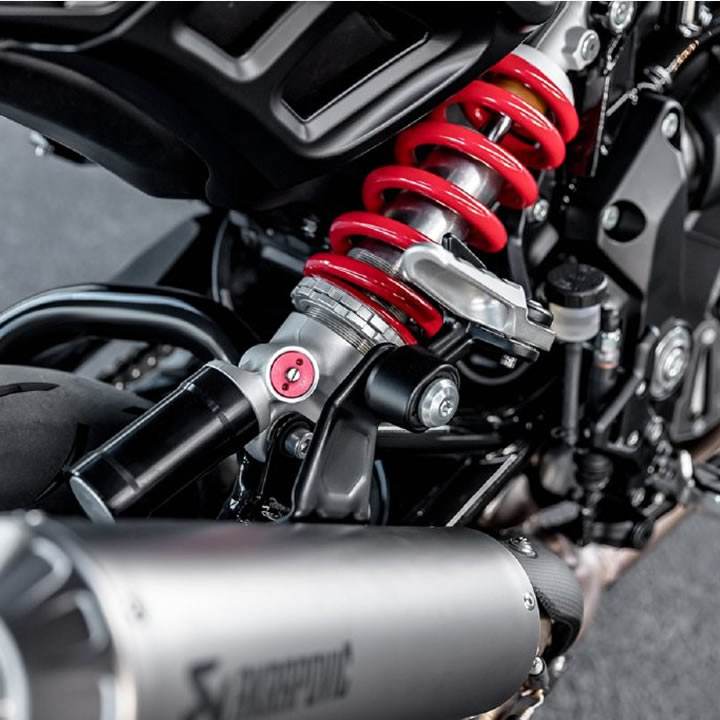Harley riders used to be passionate motorcyclists. They even know more details about their bikes and different parts. However, you may not know the technical details of suspension in a motorcycle, but, of course, know the basics and how necessary it is.
It’s, if not the most, one of five unavoidable parts of any motorcycle.
Whatever the way – street, trail, or rocky terrain – the rightly adjusted shock will make your journey safe and comfortable. It helps riders keep control of their bikes while accelerating, turning, and breaking, or against hits, bumps, and cracks.
Remember, a comfortable seat cannot only ensure the desired comfort unless the bike has a good suspension.
What is Motorcycle Suspension?
To get the right idea about it, you need to break down the components of the suspension. The results that we get after dissection are dampers and springs. They work together to ensure a pleasant riding condition.
Spring holds the motorcycle weight, particularly the machine and rider. Spring’s work is what we know about it, meaning it acts as a counterforce against any force and absorbs shock or bumping on any road, track, or trail.
It keeps the motorcycle, including all of its parts, safe during the ride.
But riding on a shock only will not work out as we expect. We can hardly move on, as there will be continuous bounce and no control at all! Then what? The spring requires the right compression!
This is where the second component comes in – the damper. It slows down the compression rate by pressing springs together, commonly known as compression damping.
And after pressing it to the desired level of compression, the damper again allows it to return to the original position (with its exact shape and dimensions as required), which action is familiar as rebound damping.
In a nutshell, the spring controls the mass of your motorcycle, while the damping (by compression and rebound) controls the speed of spring movement. These two, by their combined work, keep your ride on an automotive two-wheeler comfortable.
But, one thing is still missing! To get a really balanced and controlled ride, you must get your suspension (both spring and damper) well-tuned, what we call shock adjustment!
Motorcycle Shock Adjustment
Shocks vary in terms of motorcycle variety. Consequently, even if the working procedure is the same, there will be a difference in tuning or adjusting the suspension.
Motorcycle manufacturers usually set specific shock-adjustment procedures for particular models according to a universally accepted standard and ask shock producers to follow those.
Even some renowned brands like Harley, Royal Enfield, BMW, and Yamaha have set quite a distinctive shock adjustment procedure especially suitable to bikes under their brands.
For instance, if you have a Harley and need to get a new shock for it, you will find that the H-D shock manufacturers provide particular shock-adjustment instructions for different models of Harley motorcycles.
So, it is always better to follow the instructions given by manufacturers to ensure the right shock adjustment. It’s not wise to give any specific guidelines to follow solely on this issue.
But yes, several factors like we mentioned below play a vital role in deciding how to set up motorcycle suspension correctly.
- Your weight and size;
- Weight of your luggage and packings;
- The aggressiveness you show or want to show while riding;
- On what road or terrain you’re going to ride; and
- The weather conditions.
Consider the points while following the instructions from the shock and motorcycle manufacturer, then adjust the suspension on a pro-rata basis. Never consider the adjustment appropriate the first time, especially if you’re at a beginner level.
Just give a short trial very carefully to check if it is well-adjusted and feels balanced and comfortable, then re-adjust if necessary. It’s always a good idea to set the suspension according to your riding style, and later you can re-adjust it for different terrains.
Types of Motorcycle Suspension
Generally, motorcycles have two types of suspension – Front Suspension and (ii) Rear Suspension. The following explanation will help you get a brief yet technically sound idea about these.
Front Suspension: Mainly designed for comfortable turning on the tough road corners, the front suspension uses telescopic forks. Such forks consist of large and solid hydraulic shock absorbers coming with inner coil springs.
The front-wheel can move up and down as required to make it roll, forward, and turn comfortably.
The forked bottom is linked to the front-side axle, centering what the wheel spins. Typically, the fork tube (upper portion) slides inside the body of the lower part of the fork and keeps the fork oil sealed inside it.
Forks have another type known as “Upside-Down” (USD) or “Inverted” forks that reduces unsprung motorcycle weight and offers better handling. And, we suggest USD for the front suspension.
Rear Suspension: As a critical one, the rear suspension provides chassis stability while controlling braking and holding more weight. The basic function is pretty much similar to the front one, but it has different utilities.
While resisting the driveshaft’s rotational force, the rear suspension efficiently transfers the engine torque to the motorcycle wheels.
As said, it has two components, namely spring, and damper. The bump-reducing spring supports the weight of the back part of the bike, including the rider, while the damper controls up & down oscillations of the spring to maintain a balance.
Dampers work a controlled force of friction dedicated to draining the energy out of sudden and unexpected bumps and shocks.
There are mainly two different types of the rear suspension – Twin-shock and Single-shock. Traditional Twin-shock is old aged, but yet seen in retro style motorcycles. But, the Single or Mono-shock is near-universal, the most used and popular type of suspension since its introduction.
Concluding Remarks
That is all about the basics of motorcycle suspension, including their types and adjustment. We did not have any purpose to explain things in detail but to make a blurry thing more understandable.

